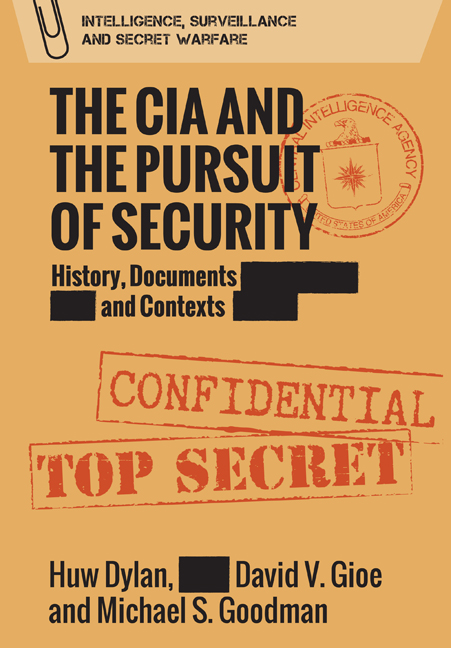Book contents
- Frontmatter
- Contents
- List of Documents
- Foreword
- Acknowledgements
- Introduction
- 1 Intelligence for an American Century: Creating the CIA
- 2 The Development of CIA Covert Action
- 3 A ‘Gangster Act’: The Berlin Tunnel
- 4 The CIA and the USSR: The Challenge of Understanding the Soviet Threat
- 5 Anglo-American Intelligence Liaison and the Outbreak of the Korean War
- 6 The CIA and the Bomber and Missile Gap
- 7 The CIA and Cuba: The Bay of Pigs and the Cuban Missile Crisis
- 8 The CIA in Vietnam
- 9 The CIA and Arms Control
- 10 The CIA’s Counter-Intelligence Conundrum: The Case of Yuri Nosenko
- 11 1975: The Year of the ‘Intelligence Wars’
- 12 Watching Khomeini
- 13 The CIA and the Soviet Invasion of Afghanistan
- 14 Martial Law in Poland
- 15 Able Archer and the NATO War Scare
- 16 The Soviet Leadership and Kremlinology in the 1980s
- 17 The CIA and the (First) Persian Gulf War
- 18 A Mole in Their Midst: The CIA and Aldrich Ames
- 19 ‘The System was Blinking Red’: The Peace Dividend and the Road to 9/11
- 20 Reckoning and Redemption: The 9/11 Commission, the Director of National Intelligence and the CIA at War
- 21 The ‘Slam Dunk’: The CIA and the Invasion of Iraq
- 22 The Terrorist Hunters Become Political Quarry: The CIA and Rendition, Detention and Interrogation
- 23 Innovation at the CIA: From Sputnik to Silicon Valley and Venona to Vault 7
- 24 Entering the Electoral Fray: The CIA and Russian Meddling in the 2016 Election
- 25 Flying Blind? The CIA and the Trump Administration
- Bibliography
- Index
12 - Watching Khomeini
Published online by Cambridge University Press: 24 September 2020
- Frontmatter
- Contents
- List of Documents
- Foreword
- Acknowledgements
- Introduction
- 1 Intelligence for an American Century: Creating the CIA
- 2 The Development of CIA Covert Action
- 3 A ‘Gangster Act’: The Berlin Tunnel
- 4 The CIA and the USSR: The Challenge of Understanding the Soviet Threat
- 5 Anglo-American Intelligence Liaison and the Outbreak of the Korean War
- 6 The CIA and the Bomber and Missile Gap
- 7 The CIA and Cuba: The Bay of Pigs and the Cuban Missile Crisis
- 8 The CIA in Vietnam
- 9 The CIA and Arms Control
- 10 The CIA’s Counter-Intelligence Conundrum: The Case of Yuri Nosenko
- 11 1975: The Year of the ‘Intelligence Wars’
- 12 Watching Khomeini
- 13 The CIA and the Soviet Invasion of Afghanistan
- 14 Martial Law in Poland
- 15 Able Archer and the NATO War Scare
- 16 The Soviet Leadership and Kremlinology in the 1980s
- 17 The CIA and the (First) Persian Gulf War
- 18 A Mole in Their Midst: The CIA and Aldrich Ames
- 19 ‘The System was Blinking Red’: The Peace Dividend and the Road to 9/11
- 20 Reckoning and Redemption: The 9/11 Commission, the Director of National Intelligence and the CIA at War
- 21 The ‘Slam Dunk’: The CIA and the Invasion of Iraq
- 22 The Terrorist Hunters Become Political Quarry: The CIA and Rendition, Detention and Interrogation
- 23 Innovation at the CIA: From Sputnik to Silicon Valley and Venona to Vault 7
- 24 Entering the Electoral Fray: The CIA and Russian Meddling in the 2016 Election
- 25 Flying Blind? The CIA and the Trump Administration
- Bibliography
- Index
Summary
The fall of the Shah of Iran in January 1979 was a momentous event. Not only had the Iranian royal family ruled for 2,500 years, but the ushering in of an Islamic Republic irrevocably altered regional politics. For the CIA the revolution came as a great surprise, and almost instantly questions arose as to why it had not been foreseen. Many accounts have concentrated on the 1979 revolution in Iran as an intelligence failure, pondering the reasons behind it. This chapter will take a different tack and will focus more squarely on CIA assessments of the main protagonist, Ayatollah Ruhollah Khomeini, rather than the revolution itself.
Khomeini was no stranger to the CIA, nor indeed to the Iranian political establishment. In fact, the Shah, who had been returned to power in 1953 following a coup, engineered in the West and orchestrated by the CIA, had long been a critic of, and target for, Iranian religious leaders. While Khomeini would not be the first Iranian religious leader to speak out against the ruling leadership, his vitriol would become one of the most vocal and prolific. For CIA analysts, writing sometime afterwards but looking at this early period (albeit with the benefit of hindsight), ‘the emergence of a strong religious leader on a national level was inevitable’. But it would be difficult to have made such a judgement at the time. A major factor behind this is contained in a post-mortem that the CIA conducted in the immediate aftermath of the revolution: collecting intelligence on domestic Iranian issues was a low priority.
The CIA post-mortem was explicit in its findings: ‘most NFAC [the CIA’s National Foreign Assessment Center] analysts began with the belief that the Shah and his regime were strong and the opposition weak and divided’. Just like a badly shaped snowball at the top of the hill, once such an erroneous assumption was used as the starting position, the process quickly moved off track and lost its shape and direction. So what was known about Khomeini and why was his trajectory misjudged?
Khomeini was born in 1902 and developed a religious identity from an early age. His first book, written in his late thirties, was as much a religious tract as a political one.
- Type
- Chapter
- Information
- The CIA and the Pursuit of SecurityHistory, Documents and Contexts, pp. 197 - 210Publisher: Edinburgh University PressPrint publication year: 2020



